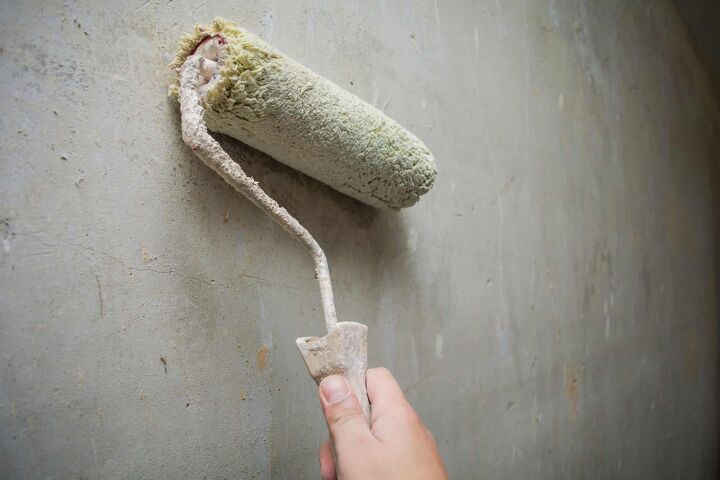What Kind Of Paint Do You Use On Concrete Basement Walls?

Painting your concrete basement can present you with multiple puzzles to solve. After you’ve decided to paint your basement, you are probably wondering which type of paint to use.
Use concrete and masonry paint for concrete basement walls so that it sticks and dries well. Masonry paint is resistant to mold and moisture which are both common in basements. Concrete paints such as Zinsser Watertite and DryLock Original will withstand moisture, chipping, and mold.
In this article, we’ll cover many critical aspects of concrete paint. We’ll go over the best brands, the most affordable options, and which type of paint is right for your specific basement. We will also give you a few tips to get started.
Do You Need to Hire a Paint Contractor?
Get free, zero-commitment quotes from pro contractors near you.

Types of Concrete Paint
| Concrete Wall Paint | Benefits | Drawbacks |
| Zinsser Watertite | 15-year Waterproof Guarantee 10-year Mold Proof Guarantee
| Slight Odor |
| DryLock Original | 10-year Warranty Withstands 10 psi of Hydrostatic pressure | Expensive |
| Kilz Basement and Concrete | 10-year Warranty Less Expensive
| Complaints of Lower Seal Quality |
| Seal-Crete DampLock | 15-year Warranty Clean White Finish | May need Multiple Coats |
You can see from the list here that the overarching theme with concrete basement wall paint is waterproof. Here is a more in-depth guide to each of these concrete paints.
Finding the Best Concrete Paint for Your Basement Wall
The table in the previous section lists several paints for sealing a concrete basement wall. But which is best?
In the next section we will go over each one in more depth so you can make the best decision for your basement.
Zinsser Watertite Concrete Paint for Basement
This paint boasts good reviews and a tight seal. You can use it for your basement, your outdoor walls and concrete fences.
Here are a few of the specs on this waterproofing paint:
- Protects against water and mold
- Withstands up to 20 psi of hydrostatic pressure
- Bright White finish
- Low-odor
- 2-hour dry time
Price: ~ $34 per gallon
Happy buyers say this paint covers their basement walls evenly, held on well, and was nice and thick out of the can.
DryLock Original Paint for Concrete Basement Wall
Drylock is widely acclaimed as one of the best options for painting and sealing the concrete walls in your basement. Drylock is designed for foundations, birdbaths, and basements.
Here are some of the specifications:
- Low Odor
- Protects against water and mold
- Withstands 10 psi hydrostatic pressure
- Beige finish
- 2-hour dry time
- 100 square feet per gallon
Price: ~ $40 per Gallon
Many users of Drylock say they like the beige finish and the fast-dry time. Drylock also has a long reputation of quality. And it is warranty backed. Overall, DryLock might be some of the best concrete basement paint on the market.
Kilz Basement Concrete Paint
This paint is a budget-friendly option. However, users are still happy with the product, and it will get the job done. Here are a few specifications:
- Water and Mold Resistant
- White finish (but is also tint-able if you want a slightly different shade)
- 12 psi hydrostatic pressure Resistance
- 75 square feet per gallon
Price: ~ $28 per gallon
You may need to apply a slightly thicker coat with this one. But, if you are working with a smaller surface area, you might just be happy with Kilz. It currently holds an almost 5-star rating on Amazon with close to 120 total reviewers.
Seal-Crete DampLock
Seal-Crete is our most budget-friendly option. However, if you just have a small area that needs to be painted, perhaps this is for you. You will certainly want to be sure you have no current water leaks or molds.
Here’s some specifications:
- Water and mold resistant
- Satin White finish
- 15-warranty
Price: ~ $25 per gallon
Some users say this paint tends to be thinner, so you probably would use several coats.
Hopefully, you have a better idea of what paint you need for your basement. Below we have several more things to keep in mind before painting.
Things to Consider Before Buying Concrete Paint for a Basement Wall
When you begin the renovation of your basement, there are a few things you need to keep in mind. Ask these questions before you purchase paint for your basement:
- Is my basement wall leaky?
- Have I had trouble with mold growing?
- Is my basement wall old?
Your answers to these questions will dictate the kind of concrete wall paint you decide to purchase. Also note: when looking for paint for a concrete basement wall, you are actually looking for a sealer. Don’t be surprised if there are less color options.
My Basement Wall Leaks
If your basement wall leaks a lot, before you buy any paint, you need to seal the leaks’ source. This is imperative. You are adding a layer of waterproofing to your wall with a concrete sealer, but this is not designed to hold back serious water leaks.
If you aren’t comfortable repairing leaks, it’s recommended to have a licensed builder or repairman have a look at you walls.
Painting a wall that isn’t ready is just going to create more work in the long run.
Mold Grows in My Basement
If you have mold growing in your basement, there is a higher likelihood that you have mold growing in other areas of your home. Address mold immediately. Mold will not only become a structural issue, but it is also a health problem. You don’t want to subject you or your loved ones to something dangerous.
First, have the mold removed, then consider painting with the mold-resistant paints we’ve listed.
My Concrete Basement Wall is Old
This isn’t necessarily a bad thing. Some old basements are better than others. But if you have an old basement, you probably don’t want to skimp in the type of concrete paint you buy.
You want to buy the most quality concrete paint and sealer available. A new home might be able to get away with a cheaper option, but an old home that is prone to problems should get the best around. Buy nice or buy twice.
Can I Paint Over the Concrete Sealer with a Normal House Paint?
The answer is probably not. When you paint your concrete basement wall, the watertight seal doesn’t allow a good surface for other paint to bind to. As a result, you will have a lot of peeling and flaking in little time.
However, if you want a slightly different color for your basement walls, often times you can buy a “tinter.” Basically, this will be added to your current concrete paint and result in a slightly different paint color.
How to Paint Concrete Basement Walls
After you’ve chosen the right paint to go on your concrete basement walls, you can begin the process. Follow these steps to properly prepare, prime, and paint concrete basement walls:
- Open windows. When painting, it’s always important that you have proper ventilation in the work space. If you don’t have windows in your basement, position a few fans towards the opening of the door to allow the fumes to escape.
- Put on safety gear. Wearing the appropriate safety gear will prevent you from inhaling fumes and also keep you clean while working. Wear long sleeves, thick gloves, a mask, and goggles.
- Prepare the surface. Before you proceed with painting concrete, you want to prepare the surface. To do this, strip off any old paint with a wire brush and paint scraper. Then, follow up by sanding the surface with a fine-grit sandpaper. Since this will create quite a bit of dust, make sure that you clean the concrete thoroughly and let it dry before you continue.
- Seal and prime the concrete. Since concrete is porous, it’s very easy for water to travel through it. Sealing interior concrete walls is absolutely crucial to prevent moisture, mold growth, and that damp basement feel. Consider using a masonry sealer that is also designed to patch up any cracks in the surface. After sealing, use a waterproof primer to even out the surface even further. Most primer dries in two hours. However, you should wait at least eight hours after applying before you begin painting.
- Paint the concrete. With the waterproof masonry paint that you’ve chosen and a natural roller, with a thick nap, start painting the larger surfaces and use back-and-forth vertical strokes. To fill in the pores completely, cover each area about 3-4 times with the roller. You’ll most likely need 2-3 coats but make sure to allow the paint to dry for entire day between each one.
Do You Need to Hire a Paint Contractor?
Get free, zero-commitment quotes from pro contractors near you.

Our Final Word
Do your research, and don’t be afraid to try different things. If you have a large project and need a space covered that is greater than 500 square feet, consider buying a small quantity of different kinds of concrete sealer to see how they compare.
Always remember to be safe when painting anything. Wear masks and provide yourself with proper ventilation while painting. As you probably know, painting can be a lot of work. Keep at it, but take breaks as needed.
Before you know it, you will have a beautiful basement wall that is better protected from the elements.

We are a team of passionate homeowners, home improvement pros, and DIY enthusiasts who enjoy sharing home improvement, housekeeping, decorating, and more with other homeowners! Whether you're looking for a step-by-step guide on fixing an appliance or the cost of installing a fence, we've here to help.
More by Upgraded Home Team



























